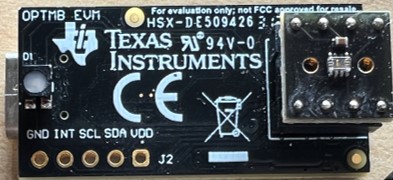SBOU293D November 2022 – January 2024
- 1
- Abstract
- Trademarks
- 1Overview
- 2OPTEVM Hardware Overview
- 3OPTEVM Software
- 4Schematic, PCB Layout, and Bill of Materials
- 5Troubleshooting
- 6Revision History
Abstract
This user’s guide describes the characteristics, operation, and use of the OPT light sensor evaluation modules (OPTEVM). The user's guide details how to set up and configure the software and hardware, and reviews various aspects of the program operation. Throughout this document, the terms evaluation board, evaluation module, and EVM are synonymous with the OPT light sensor EVM (OPTEVM). This document also includes an electrical schematic, printed circuit board (PCB) layout drawings, and a parts list for the EVM.
This user's guide is applicable for the following devices:
Table 1-1 Devices Supported
| Device | Description |
|---|---|
| OPT3005DTSEVM | Ambient Light Sensor (ALS) for Video Surveillance Cameras |
| OPT4001DTSEVM | High-Speed, High-Resolution, Digital Ambient Light Sensor (ALS) |
| OPT4048DTSEVM | High-Speed, High-Precision Tristimulus XYZ Color Sensor |
| OPT4060DTSEVM | High-Speed, High-Sensitivity RGBW Color Sensor |
| OPT4001DNPQ1EVM | Automotive High-Speed, High-Resolution, Digital Ambient Light Sensor (ALS) |
| OPT4003DNPQ1EVM | Dual channel (ALS + IR) Automotive High-Speed, High-Precision Digital Ambient Light Sensor (ALS) |
